How to Cite | Publication History | PlumX Article Matrix
Effect of Irrigation and Fertilizers on Rice Yield in Conditions of Kyzylorda Irrigation Array
Axaule Ondasynovna Olzhabayeva1 , Alexey Grigoryevich Rau1 , Erbol Sarkynovich Sarkynov1 , Zhanuzak Nurdildaevich Baimanov2 and Asylkhan Ashimovich Shomantaev3
1Kazakh National Agrarian University, The Republic of Kazakhstan, 050010 Almaty, Abai 8.
2Kazakh Research Institute of Rice named after I. Zhakhaev, The Republic of Kazakhstan, Kyzylorda, 120008, Abay Avenue, 25 b.
3Kyzylorda State University Korkyt Ata, The Republic of Kazakhstan, Kyzylorda, ul. Ayteke Bi, 29 A.
DOI : http://dx.doi.org/10.13005/bbra/2363
ABSTRACT: The rice root nutrition is easy to regulate, and, therefore, it is the basis of high yields. It still remains unknown how the absorbed salt is used at different vegetation phases, so it is not always possible to explain the real causes of low yields. Most often it is associated with poor climatic conditions in the year. However, weather conditions cannot explain the lack of crop growth with an annual increase in the amount of fertilizers applied. The field experiments have been conducted to determine the standards and timing of fertilizers application for rice on degraded lands (Nauryzbai section), which provides a high rice yield and the efficiency of irrigation water use. The trial establishment on the standards and terms of mineral fertilizers application at a rate has been performed to determine the optimal fertilizer rate (N120P90K60; N150P90K60; N180P90K60.) According to the results, the optimal fertilizer rate after melilot is N150P90K60.
KEYWORDS: irrigation regime; rice irrigation system; mineral fertilizers; salinization; land improvement activities; drainage
Download this article as:| Copy the following to cite this article: Olzhabayeva A. O, Rau A. G, Sarkynov E. S, Baimanov Z. N, Shomantaev A. A. Effect of Irrigation and Fertilizers on Rice Yield in Conditions of Kyzylorda Irrigation Array. Biosci Biotech Res Asia 2016;13(4). |
| Copy the following to cite this URL: Olzhabayeva A. O, Rau A. G, Sarkynov E. S, Baimanov Z. N, Shomantaev A. A. Effect of Irrigation and Fertilizers on Rice Yield in Conditions of Kyzylorda Irrigation Array. Biosci Biotech Res Asia 2016;13(4). Available from: https://www.biotech-asia.org/?p=17142 |
Introduction
In Kazakhstan, rice growing is concentrated in two oases – in the valleys of the Ili and Karatal rivers and in the lower reaches of the Syrdarya River, in the territory of Kyzylorda and South Kazakhstan regions. In the valleys of the Ili and Karatal, the Dungans and Taranchi, who relocated here in 1871-1882 from the Ghulja Province of China, began to cultivate rice. They brought with them not only the seeds of rice, but also the experience in irrigational construction.
The rapid growth of the cotton and rice-growing area in the early 1880s in Central Asia caused serious competition for water between the two cultures. In this regard, it became necessary to move the rice crops in new areas. So in 1895 the research and studies with the aim of drawing up a new irrigation projects were initiated. These works were carried out primarily in the ancient irrigation lands on the left bank of the Syrdarya River from Golodnaya Steppe to the dry riverbed of the Zhanadarya River. The attempts to develop these lands for irrigated agriculture promoted the rice crop in more northern areas, i.e. the lower reaches of the Syrdarya River, the current territory of Kyzylorda region. Here, the first rice crops were planted in 1896, and already in 1897, approximately 300 hectares were adopted for rice [1].
Rice was and is mainly cultivated in Kyzylorda region – in the lower reaches of the Syrdarya River, where grows more than 90% of rice crops of the Republic and the majority of farms is specialized in the cultivation of this crop.
The climate of the area located within the plain of the ancient part of delta of the Syrdarya River is characterized by sharp continentality. Continentality is manifested in large annual and daily amplitudes of air temperature and in the climatic indicators instability every year. Summers here are hot and long, and winters are moderately cold and short. The annual rainfall is 129 mm. Most of the precipitation occurs during the warm season.
Research and production sites of the Kazakh Research Institute of Rice named after I. Zhakhaev are located in the eastern part of Pravoberezhny Kyzylorda irrigation array. In 1967, under the project of the Kyzylorda department of “Soyuzgiproris” Institute, a rice irrigation system, which is a seven-field rotating area of 684 hectares, was built there. A variety of field trials to optimize the fertilizer system of the rice culture, on the study of water-salt regime, to improve soil fertility, and other trials are conducted in rice paddies of Karaultyubinsky experimental farm.
Currently, in Kyzylorda region eight sorts of domestic breeding are officially zoned, namely: Marzhan, Aral 202, Aru, Madina, Togusken 1, Aru, KazNIIR-5, KazEr-6, and five sorts of Russian breeding: Novator, Leader, Yantar, Fischt, and Anait. Of the 12 sorts admitted to use in the Kyzylorda region for the southern zone of rice cultivation (Zhanakorgan and Shiely districts) it is recommended to cultivate middle-grade sorts, such as Marzhan, Togusken 1, Aral 202, Leader; for the middle zone – Marzhan, Togusken 1, Madina, Yantar, Fischt, KazEr-6 KazNIIR 5, for the northern zone – KazNIIR-5, KazEr-6, Aru, Anait, and Novator [2].
The experience in operating the irrigation systems shows that on modern irrigation systems, the size of the water intake from the irrigation sources is predetermined by their water content, the crop requirements, and varies widely from 5 to 25 thousand cu.m/ha. It was found that plants use about 30-35% of the water diverted from irrigation sources. The rest is spent for technological losses (filtering in the channels, filtering on irrigated lands in transportation of water from the irrigation sources to the plants [3].
Currently, the irrigation norms (net) on the rice-growing arrays of Kyzylorda region range from 18,760 to 21,750 cu.m/ha, and the gross rate is from 28,000 to 32,450 cu.m/ha. Observance of proper irrigation regime in the rice fields is the key to high productivity. Such water regime can be implemented only on the well-designed rice fields. Rice irrigation regimes may be different depending on the degree of soil salinity, weed control methods, and other conditions.
Unlike other crops, rice is cultivated mainly upon creation of a layer of water on the field during most part of the growing season. Rice, grown without soil flooding, but with it periodic watering, always produces reduced crops.
Specific soil conditions, created in the flooded rice field, cause many of the features in the phenomena and processes related to rice nutrition.
Shortly after the soil flooding, the lack of free oxygen occurs and strongly pronounced regenerative processes develop. However, this does not degrade, but rather improves the conditions for nutrition and growth of rice plants. It was found that the rice field flooding with water layer promotes the accumulation of ammonia nitrogen and exchange potassium available to rice, increases the mobility of the phosphorus compounds, and provides favorable conditions for the intake of food elements to the rice roots. In a strongly reduced soil of flooded rice field, the mineralized nitrogen accumulates mainly in the form of ammonia, and nitrates are formed only in thin oxidized layers of soil around the active rice roots. Thus, the ammoniacal nitrogen is the main source of the rice nutrition with nitrogen in the flooded field [4].
The high efficiency of nitrogen fertilizers for rice was noted by many researchers. Despite the low rate of nitrogen application, nitrogen fertilizers provide high gain and significantly increase the total nitrogen yield by rice crop. Nitrogen fertilizers required for rice in large quantities are very mobile in the soil and is, therefore, one of the main sources of environmental pollution. At the same time, in the system of application of nitrogen fertilizers, providing their high return on the crop, the right choice of forms, methods and timing of nitrogen fertilizers application are more important, as well as the use of substances that suppress the nitrification process, which is the main source of nitrogen losses in flooded rice soils [ 5].
Phosphate fertilizers are ineffective on many soils of rice paddies. This is not due to the transition of applied fertilizers in a condition hardly accessible for the rice, but due to favorable conditions for the mobilization of forms of phosphorus compounds available to rice in the soil of flooded rice field.
Despite the large consumption of potassium by rice from the soil, often potash fertilizers are ineffective, since upon sharp change of redox regime of soil in the flooded rice fields the conditions for intensive mobilization of potassium from the potassium-containing soil minerals are created.
Creating a layer of water on the rice field improves the conditions of rice nutrition with carbon dioxide. Its large part which is formed upon decomposition of organic substances is released near the rice roots, where oxidative processes are most intense. Part of the carbon dioxide is absorbed by the rice for the needs of the synthesis. While reducing its temperature during the night hours, the irrigation water accumulates carbon dioxide unnecessary for the plants at that momen, and enriches its atmosphere in the rice haulm stand at higher temperatures in the daytime, when the plants have high demand for carbon source for assimilation. During its greatest intensity in rice, the daily rice intake of carbon dioxide is up to 300-350 kg/ha per day.
Therefore, to obtain high yields the genesis of soils and its reclamation condition, rational flooding regime, uniform arrangement and sufficient density of plants, as well as standing and highly productive sorts adapted to local conditions are also of significant importance.
Minerals are a mandatory part of the rice plant and are found in all its organs in an amount that depends on their age and growing conditions.
Prior to tillering, rice consumes relatively small amounts of nutrition elements from soil. 70-80% of them are absorbed by the plants from the soil in the period between tillering and the beginning of flowering. The rice accumulation occurs in the maturation stage.
Rice has a number of biological features, which often limit the effectiveness of cultivation methods and even the use of fertilizers. These features include the following: low field germination of seeds; uneven plant population in sowing due to various reasons (unevenness of water layer upon insufficient floating), slow initial growth; significant loss of plants during the growing season; transformation of the roots as an inevitable consequence of the paddy flood; toxic effects of hydrogen sulfide and other products of anaerobic processes; age-related changes of rice response to ammonium and nitrate form of nitrogen fertilizers; physiological heterogeneity of shoots within one plant, depending on the power and timeliness of tillering; increase of this heterogeneity of the rice bush from high rates of nitrogen fertilizers (especially, those applied after the phase of 7-8th leaf); lack of stability in the initial phases of the development to the wind; products of anaerobic biological activity of the soil, as well as lodging in the background of increasing rates of mostly nitrogen fertilizers; reduction of grains/year rate of heads mostly in lateral shoots at increased and belated application of nitrogen fertilizer as a result of antagonism between vegetative and generative development of plants; competitive relationship between the main and side shoots, reaching a significant force in the wrong mode of nitrogen supply, with corresponding negative consequences for the rice grain production. In correct application of fertilizers to rice, it is important to take into account the discrepancy between the periods of greatest absorption of nutrients and responsiveness to the fertilizer applied. Rational mineral nutrition regime should be based not only on the early “reserve” application and not on meeting the needs of gradually changing rice need to absorb the corresponding element, but on the targeted exposure to fertilizer that stimulates organ-forming processes [6].
The low efficiency of current water management activity in rice irrigation systems is also due to the fact that it is aimed at achieving the interim, short-term goals, which do not provide a holistic solution of water problems, while sustainable water use should be based on a balance of economic, social and environmental interests in the region [7-8].
Materials and methods
The research works were carried out on the lands of the Kazakh Research Institute of Rice. These lands have not been used for over 20 years, and after the rehabilitation irrigation and drainage works the rice cultivating has been resumed. The water-metering devices were installed on the trial sites before the rice sowing, as follows: to determine the volume of water the Ivanov weir and automated water supply and discharge plants were installed on 2 paddies, in the channels – the channel controls and bridges, to measure water flow in the channels of GR-21M, well-piezometers to monitor the level and salinity of groundwaters. Determination of the water balance on the trial site was conducted by the method proposed by V.B. Zaytsev. The total water consumption was studied by evaporation vessels with the cross-sectional area of 0.2 sq.m. Observations were made 2 times a day (at 9 a.m. and 5 p.m). To keep the required water layer they were filled up. The amount of water filled up showed its debit for the interval between observations. Phenological and reclamation sites have been allocated on rice paddies to monitor the salinity of the water and the condition of the rice plants.
Research results
The trial field soil is characterized by heavy texture with a clear sign of gleying. The sporadical cane with the height of 20 cm grows. Before the trial establishment we have studied the soil cover of the trial field for which were laid sections (Figure1, Table 1).
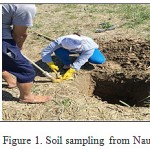 |
Figure 1: Soil sampling from Nauryzbai site Click here to View figure |
The examination of the selected trial site in the first year of development with an area of 20 hectares has shown that the soils are strongly saline in the 0-50 cm layer, the degree of aggregation in depth is reduced from 74-80% to 28-35%, humus content is from 1.51% to 0.81%, and the proportion of exchange magnesium in the composition of absorbed bases increases from 14-30% to 39-57% of the total amount. Salinity type – chloride-sulphate sodium.
Table 1: Water-physical properties of soils and soil moisture water exchange
| Soil layer, cm | Weight by volume, g/cu.cm | Specific weight, g/cu.cm | porosity, % | Hygroscopic humidity, % | volumetric water content before washing, % | Specific minimum moisture-holding capacity, % | Soils water yield volume, % | Volume of water dissolving the salt in the soil layer, l/cu.m |
| 0-20 | 1.40 | 2.59 | 46 | 4.6 | 32.2 | 32.4 | 9.8 | 74.5 |
| 0-40 | 1.48 | 2.69 | 45 | 4.7 | 28.5 | 34.8 | 6.7 | 72.4 |
| 0-60 | 1.50 | 2.69 | 44 | 4.6 | 30.4 | 39.7 | 1.2 | 70.9 |
| 0-100 | 1.52 | 2.74 | 45 | 4.4 | 30.7 | 40.3 | 1.7 | 146.2 |
| 100-160 | 1.47 | 2.61 | 44 | 4.0 | 31.3 | 37.6 | 3.5 | 216.0 |
Cultural and technical works were carried out on the trial area in order to engage the degraded lands in the agricultural use, namely: clearing the area of trees and shrubs; stump extraction; planning works (Figure 2).
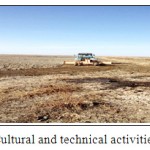 |
Figure 2: Cultural and technical activities on Nauryzbai site Click here to View figure |
Field planning provides for simultaneous shoots of crop, quality humidification of plants throughout the site, saving irrigation water, preventing unproductive water losses and deterioration of land reclamation condition.
Alignment of the paddy surface was carried out by successive circular passages of the planner along the yards of the previous ploughing. The leveling survey, followed by planning using longspan planner, was performed on the trial area of 20 ha (Figure 3).
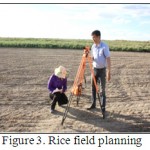 |
Figure 3: Rice field planning Click here to View figure |
The studies on the effect of structuring on the economic performance of rice cultivation by the area have shown that upon deviation of marks of the paddy surface from ± 3 to ± 5 cm the damage caused by a shortfall will be $200 US per hectare, each additional centimeter of poor planning of rice paddy surface will bring to damage of $100 US per 1 hectare. In the event of deviation to ± 10 cm the damage increases 3-4 times [9].
In the selected section, the water-balance areas were created, the Chipoletti weirs and automated paddy water supply and discharge plants were installed (Figure 4).
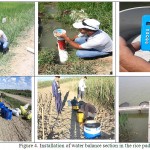 |
Figure 4: Installation of water balance section in the rice paddy Click here to View figure |
The results of the analysis of the samples of water supplied to the paddies showed that by the chemical composition they belong to the class of hydrocarbon ones. They have a relatively stable mineralization (Table 2, Figure 5) and are classified as moderately saline waters, not requiring special measures aimed at soil salinity control and not entailing a potential danger of soil alkalinization.
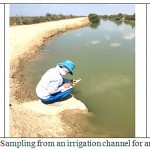 |
Figure 5: Sampling from an irrigation channel for analysis Click here to View figure |
Table 2: Mineralization of irrigation water supplied to the paddies
| Location of water sampling | Solids | pH | Anions g/l / mg-eq/l | Cations g/l / mg-eq/l | Mineralization, g/l | |||||
| CO3 | HCO3 | Cl | SO4 | Ca | Mg | Na+K | ||||
| 1 | 2 | 3 | 4 | 5 | 6 | 7 | 8 | 9 | 10 | 11 |
| First year of development | ||||||||||
| May | 1.116 | 6.5 | 0 | 0.145 | 0.12 | 0.392 | 0.11 | 0.059 | 0.085 | 0.982 |
| 0 | 1.985 | 3.585 | 8.158 | 5.0 | 5.223 | 3.252 | ||||
| June | 1.040 | 7.75 | 0 | 0.183 | 0.17 | 0.442 | 0.12 | 0.079 | 0.104 | 1.007 |
| 0 | 3.001 | 4.794 | 9.206 | 6 | 6.494 | 4.507 | ||||
| July | 1.224 | 8.03 | 0 | 0.153 | 0.17 | 0.442 | 0.12 | 0.078 | 0.094 | 1.057 |
| 0 | 2.509 | 4.794 | 9.206 | 6.00 | 6.412 | 4.097 | ||||
| August | 1.168 | 8.28 | 0 | 0.153 | 0.160 | 0.551 | 0.11 | 0.132 | 0.050 | 1.156 |
| 0 | 2.509 | 4.494 | 9.206 | 6.00 | 8.878 | 1.631 | ||||
| Second year of development | ||||||||||
| May | 1.056 | 7.70
|
0 | 0.240 | 0.095 | 0.447 | 0.190 | 0.030 | 0.091 | 0.974 |
| 0 | 3.936 | 2.679 | 9.321 | 9.500 | 2.466 | 3.970 | ||||
| June | 1.4 | 6.27 | 0 | 0.450 | 0.080 | 0.660 | 0.260 | 0.102 | 0.046 | 1.373 |
| 0 | 7.380 | 2.256 | 13.744 | 13.000 | 8.384 | 1.996 | ||||
| July | 0.984 | 6.25 | 0 | 0.270 | 0.100 | 0.441 | 0.180 | 0.060 | 0.057 | 0.973 |
| 0 | 4.428 | 2.820 | 9.180 | 9.00 | 4.932 | 2.496 | ||||
| August | 0.880 | 7.50 | 0 | 0.240 | 0.085 | 0.365 | 0.200 | 0.042 | 0.011 | 0.823 |
| 0 | 3.936 | 2.397 | 7.603 | 10.00 | 3.452 | 0.484 | ||||
The studies found that the best option of rice irrigation regime for Kyzylorda array of irrigation on saline soils of chloride-sulfate type is a permanent type of salinity with a variable water layer from sowing to milk line. After sowing of rice the flooding of the paddy surface to a depth of 10-15 cm occurs, and then three days later a forced full discharge of water is performed. Thereafter, the flooding of paddies is performed. The breaks are not allowed between the discharge and flooding.
Before the rice tillering, the water supply to the paddies decreases so that the layer of water decreases to 5 cm and is kept so for 6-10 days, till the end of tillering. Until full milk line of the rice grain, the layer of water in paddies is maintained at the level of 10-15 cm. In the subsequent period until the heading phase, the water shall be periodically replaced, and the operation shall be performed taking into account the irrigation coefficient in chlorine concentration of 0.2-0.25 g/l. Water supply to the paddies is terminated at the stage of full milk line. The water from paddies is not discharged at the end of the irrigation period; it is gradually absorbed into the soil. This saves the plants from lodging (Table 3).
Table 3: Structure of the irrigation rate of rice paddy
| Items of balance sheet | First year | Second year | ||
| cu.m/ha | % | cu.m/ha | % | |
| Water supply | 24,030 | 99.18 | 22,400 | 99.02 |
| Precipitaion | 320 | 0.82 | 220 | 0.98 |
| Total | 24,350 | 100 | 22,620 | 100 |
| Soil saturation | 4,460 | 18.46 | 4,100 | 18.0 |
| Evapotranspiration | 10,367 | 42.93 | 9,680 | 42.49 |
| Discharge | 1,000 | 4.14 | 1,200 | 5.27 |
| Filtration flow and outflow to drainage network | 8,324 | 34.47 | 7,800 | 34.24 |
| Total | 24,151 | 100 | 22,780 | 100 |
| Disparity | -121 | 0.50 | -160 | 0.70 |
Against the background of Cartesian discharges, the desalination occurred on average at a depth of 0.5 m. Removal of salts on the dry residue amounted to 35-45, and on chlorine-ion – 54-86%.
The cultivation of flooded rice crop affects the ground waters dynamics, the mineralization of which is 14-91 g/l. During all the years of research, the closing of groundwater and irrigation water occurred in the second to fourth day. With the cessation of water supply to the paddies, the water on the paddy surface remained for 4-10 days and after that the level of ground water has been reducing. The speed of the levels rise and drop depends on the area drainage conditions. With the array development, the ground water level rose from 300 to 220 cm in two years. Only after the rice re-growing on the dry residue groundwater salinity decreased by 70-80% on chlorine-ion, and on chlorine-ion – by 85-90%.
Upon the soil moisturizing, the most part of the rise seeds with the access to oxygen retained the viability and gave simultaneous, well-rooted seedlings. During full sprouts of the rice plants, the shoots were treated with herbicide “Gulliver” at a rate of 25 g/ha.
The registration tests results showed that the optimal rate of Gulliver manufactured by DuPont de Nemours International SA is 0.020-0.030 kg/ha, where the highest biological efficiency was achieved, and the death of millet weeds was 94.4%, and bolboschoenus – 97.0%. Having measured the required rate of Gulliver, it should be mixed with a few liters of water, after which it is necessary to add Trend 90 (adhesive) into the solution and stir the mixture well.
Due to the strong secondary salinization of soils in the first year of developmenr of degraded lands 5.6% of salts in 0-5 cm layer in Kyzylorda irrigation array upon application of 150 kg/ha of active nitrogen ingredient, the rice yield amounted to: Anait – 31.4 c/ha, Tugusken – 34.4 c/ha.
The trial establishment on the desoxidated and degraded lands (20 ha) of the rice system of the Kazakh Research Institute of Rice named after I. Zhakhaev in the second year was carried out on the standards and terms of application of mineral fertilizers N120P90K60; N150P90K60; N180P90K60. Rice was grown with the use of three doses of fertilizers. The technology of growing was common for the areas.
It is known that the mineral fertilizer efficiency largely depends on the density of plants. Therefore, according to the recommendations of the Kazakh Research Institute of Rice named after I. Zhakhaev, the study of the impact of different rates of nitrogen on the yield of Leader rice variety was conducted. The studies showed that the effect of nitrogen fertilizers is more pronounced at low seeding rate – 3 million of germinable seeds per 1 ha. By providing the best nutritional regime of soil, fertilizers create favorable conditions for the crop formation. The rise yield increases with the increase of the rate of fertilizers. According to the indicators of the yield structure, the high productivity is observed at rates of N150P90K60; the biological yield was 47.5 c/ha, which is 1.5 times higher than in the first year of development (31.4 c/ha).
According to the results, the optimal fertilizer rate for rice after melilot is N150P90K60. Increasing the nitrogen rate to 180 kg does not provide a significant yield increase (49.2 – 47.5 = 1.7 kg), and at this dose of nitrogen the growing season of rice increases, which leads to blind-seed desease in heads.
All this suggests that the rates of mineral fertilizers for rice and the ratio of nitrogen and phosphorus fertilizer are determined by soil fertility and biological characteristics of the sort.
During the years of research, the growth and development of plants improved on average: on plant density by 35-60%, on the total number of productive stems to 20%, on the height of plants – by 60%, on the average weight – by 12%, and on the weight of 1000 grains – by 5%. This has contributed to the production higher yields on degraded site.
Experiments have shown that moderate fertilization with nitrogen at the beginning of stooling can be quite effective upon the provision of plants with this element starting from the initial phases of development [10].
Conclusions
The research works were carried out on the lands of the Kazakh Research Institute of Rice. These lands have not been used for over 20 years, and after the rehabilitation irrigation and drainage works the rice cultivating has been resumed.
The conditions extremely unfavorable for the production of rice are created in saline soils, resulting in a significant decrease in yield. At the same time, the use of mineral nutrition increases the salt tolerance, as well as productivity of rice.
The research has established that rice has several peaks of nitrogen consumption: in the tillering and heading phase. These indicated peaks of nitrogen consumption by rice should determine the timing of nitrogen application. However, upon rice dressing using agricultural aircraft a part of fertilizers is lost getting on interpaddy spaces, roads, irrigation and drainage channels. Therefore, the local application of nitrogen, which creates conditions for minimum loss and maximum intake of elements by plants, and the application of nitrification inhibitors, the use of which together with fertilizers inhibits the nitrification process for 1.5-2 months and thus contributes to the preservation of nitrogen in the ammonium form, are promising in the improvement of the efficiency of nitrogen fertilizer.
At high doses of nitrogen application, the rice breed Leader, which is less responsive to excessive fertilizer N180P90K60, absorbs more nitrogen, and plants develop better, especially at the early stage, than in highly responsive breeds, but then the amount of nitrogen absorbed is significantly reduced. According to the results, the optimal fertilizer rate for rice after melilot is N150P90K60.
Formation of a crop occurs upon the interrelation of the plant genotype with soil-reclamation, agro-technical, engineering, technical, organizational and technical conditions and environmental factors.
The article was written as a result of the target program: “Water and land management on irrigation and water systems of Kazakhstan”.
References
- Zhaylybay K.N. (2001). Fotosinteticheskie i agroekologicheskie osnovy vysokoy urozhaynosti risa [Photosynthetic and Agro-Ecological Basis of High Rice Yields] (pp. 4-10). Almaty: Bastau.
- Umirzakov, S.I., Tokhetova, L.A., & Tohtamysov, N.M. (2015). Tekhnologiya vozdelyvaniya sel’skokhozyaystvennykh kul’tur v risovykh sistemakh [The Technology of Cultivation of Crops in Rice Systems] (pp. 4-6). Karaganda.
- Rau, A.G. et al. (2014). Research of the Rice Productivity on Saline Lands of Rice Systems in Kazakhstan Republic. Life Science Journal, 11.
- Neunylov, B.A. (1961). Povyshenie plodorodiya pochv risovykh poley Dal’nego Vostoka [Increase of the Far East Rice Fields Soil Fertility] (pp. 6-7). Vladivostok.
- Tautenov, I.A., & Kaymoldayeva, K. (2012). Effektivnost’ azotnykh udobreniy v risovodstve [The Efficiency of Nitrogen Fertilizers in Rice Growing]. In Materialy mezhdunarodnoy nauchno-prakticheskoy konferentsii “Nauchno-innovatsionnye osnovy razvitiya risovodstva v Kazakhstane i stranakh zarubezh’ya” [Proceedings of the International Scientific and Practical Conference “Scientific and Innovative Basis for the Rice Growing Development in Kazakhstan and Abroad”] (pp. 251-253). Kyzylorda.
- Volkov, A.I., & Karazhanov, K.D. (1975). Melioratsiya zemel’ i razvitie risoseyaniya v Kazakhstane [Land Reclamation and Development of Rice Growing in Kazakhstan] (pp. 68-69). Alma-Ata.
- Amirgaliyev, N.A. (2007). Aralo-Syrdarinskiy basseyn: gidrokhimiya, problemy vodnoy toksikologii [Aral-Syrdarya Basin: Hydrochemistry, Water Toxicology Issues]. Almaty: Bastau.
- Ibragimov, G.A. (1973). Ispol’zovanie kollektorno-drenazhnykh vod dlya orosheniya zemel’ v Uzbekistane [The Use of Collector and Drainage Water for Irrigation in Uzbekistan]. Moscow: Kolos.
- Tattybaev, H.A., & Mirsaitov, R.G. (2012). Lazernaya planirovka – resursosberegayushchaya tekhnologiya ratsional’nogo ispol’zovaniya orositel’noy vody [Laser Planning – Resource-Saving Technology of Rational Use of Irrigation Water]. In Materialy mezhdunarodnoy nauchno-prakticheskoy konferentsii “Nauchno-innovatsionnye osnovy razvitiya risovodstva v Kazakhstane i stranakh zarubezh’ya” [Proceedings of the International Scientific and Practical Conference “Scientific and Innovative Basis for the Rice Growing Development in Kazakhstan and Abroad”] (pp. 346-347). Kyzylorda.
- Otchet o nauchno-issledovatel’skoy rabote po vypolneniyu uslug v ramkakh gosudarstvennoy byudzhetnoy programmy “Upravlenie zemel’nymi i vodnymi resursami na risovykh orositel’nykh sistemakh” [Report on the research work for the provision of services in the framework of the state budget project “Land and Water Management in Rice Irrigation Systems”]. (2015). Almaty.

This work is licensed under a Creative Commons Attribution 4.0 International License.





